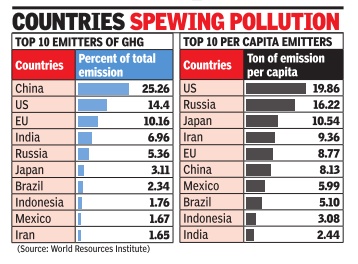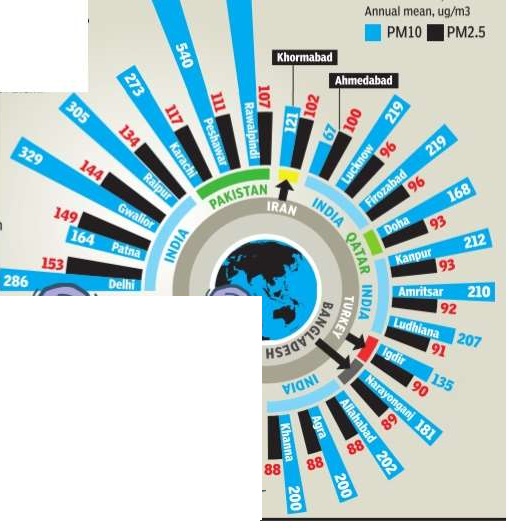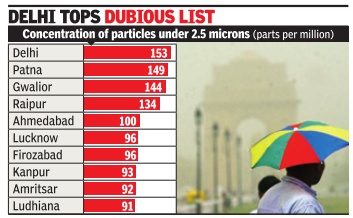Air pollution: South Asia
This is a collection of articles archived for the excellence of their content. |
Contents |
2012: Emission of green house gases
The Times of India, Jun 25 2015

Vishwa Mohan
On per capita terms, India far behind top 3 emitters
As the global community gears up for the crucial Paris climate summit, the World Resources Institute (WRI) -a global research organization -has come out with its latest analyses of the country-wise emissions of climate-damaging greenhouse gases. It shows India, despite being the fourth largest carbon emitter, continues to be far behind the other three top big emitters in terms of per capita emission. Though the data, released by the WRI, cannot be used as an excuse by India for not acting against its emission, such figures will certainly give the country an upper hand while negotiating for a global climate deal. India invariably uses the `per capita' yardstick while insisting on more comprehensive actions from rich nations. However, developing countries like China, Mexico and Brazil too are way ahead of India in terms of their per capita contribution to the overall emissions. And, this is the reason why a section within the Indian government has time and again argued not to compare the country's action with that of the Chinese goal.
The WRI analysis is based on data from its Climate Analysis Indicators Tool (CAIT) that has recently released its emission figures for the year 2012. It also came out with details as how the various economic sectors have contributed to the overall emission. “Per capita emissions are still distributed unequally“, it said, pointing out that the per person emissions still vary among the top 10 emitters, with the United States' per capita emissions eight times that of India.
According to the figures, the largest emitters contribute a majority of global emissions as the top 10 emitters contribute over 72% of global greenhouse gas emissions (excluding land use change and forestry). On the other hand, the lowest 100 emitters contribute less than 3%.
“While universal climate action is necessary, significant mitigation actions are needed by the largest emitters, taking into account that they have different capacities to do so,“ said the WRI in its document.
It shows the energy sector is the dominant source of greenhouse gas emissions. It contributes more than 75% of global emissions. “ A rapid transformation of the energy sector by 2050, as the G7 (top rich countries) suggested in their announcement, is necessary to avoid the worst impacts of climate change,“ it said.
The analysis also shows that emission sources vary by country . While the energy sector dominates, industrial emissions in China contribute more than 3% of global emissions and new data from the Food and Agriculture Organization (FAO) indicate that agriculture contributes a notable share of Brazil's and Australia's emissions.
“Mitigation policy options that countries should therefore align with their national circumstances“, the WRI suggested while sharing and analyzing those figures. Six of the top 10 emitters are developing countries. China contributes approximately 25% of global emissions, making it the top emitter.
South Asia: 2014
The Air We Breathe
In May this year, a WHO report revealed that Delhi was the world's most polluted city. So which other cities suffer particularly bad smog?
It turns out India dominates the list, with more than half of the world's 20 most polluted cities.Including cities in Bangladesh and Pakistan, South Asia has a shocking 85% of them.
Not surprisingly, air pollution is the fifth largest killer in India, the cause of 6.2 lakh deaths last year.
The most polluted cities were determined by the annual mean of particulate matter smaller than 2.5 microns, considered the most harmful for health
Air pollution: the economic cost
‘Air pollution costing economy 3.75L cr a year’
Dipak Kumar Dash | TNN 2013/07/18
New Delhi: Outdoor air pollution in urban areas by itself claims 1.09 lakh lives of adults and 7,513 lives of children below 5 years, annually, says a latest report of World Bank. The study released on Wednesday revealed that the annual cost of environmental degradation in India is about Rs 3.75 lakh crores, which is equivalent to 5.7% of the country’s GDP.
The study commissioned by the central government has brought out how urban growth centres are choking and claims that outdoor and indoor air pollution have the maximum share of this annual burden on India’s economy. According to the estimates of the bank, outdoor air pollution accounts for 29% of this, followed by indoor air pollution (23%), cropland degradation (19%), water supply and sanitation (14%), pasture (11%) and forest degradation (4%).
The first national level economic assessment of environmental degradation in India focuses on particle pollution (PM10) from the burning of fossil fuels. This has serious health consequences, amounting up to 3% of India’s GDP and results in losses due to lack of access to clean water and sanitation, besides depletion of natural resources.
The Pollutants
EVERY BREATH YOU TAKE
Rukmini Shrinivasan | TIG
First the bad news: More than half of 130 Indian cities being monitored for air pollution are at critically polluted levels.
Now the good news: Air pollution in Indian cities has been proved to be reversible, with improvements in public transport or changing over to greener fuels, reducing pollution levels.
But, now the really bad news: With industries being relocated to the peripheries of cities, growing urbanization and poor scrutiny outside big cities, small towns are emerging as India’s pollution hotspots.
According to WHO estimates, roughly 0.1 million premature deaths annually can be attributed to air pollution. Exposure to air pollution causes both short-term and long-term health effects, from eye irritation and headaches to reduced lung capacity and lung cancer, with vehicular pollution being particularly harmful. The poor are the worst off, facing higher exposure and being unable to afford high healthcare costs. A 2005 World Bank report estimated that 13,000 lives and $1279 million were saved annually between 1993 and 2002 in five cities Delhi, Kolkata, Mumbai, Chennai and Hyderabad — as a result of measures taken to improve air quality.
A look at data for 2008 recorded by the Central Pollution Control Board (CPCB) shows that Indian cities are choked. Of the 130 cities monitored, 70 have hit levels defined as critical for the presence of PM10, tiny particles of less than 10 microns in size regarded as the most dangerous pollutant as they can go deep into the lungs. However, the top five cities are Ludhiana, Khanna (both in Punjab), Ghaziabad, Khurja and Firozabad (all in UP). Delhi, the city where judicial activism for cleaner air has led to the ejection of polluting industries, comes in at sixth place. The improvements in some major cities and the simultaneous emergence of several smaller towns as pollution hotspots shows that what we are seeing is national policy failure, says Anumita Roychowdhury, associate director of the CSE.
Northern India is far more polluted than the south, with Gobindgarh (Punjab), Kanpur (UP), Indore (MP) and Raipur (Chhattisgarh) rounding out the top-10 list. Some cities in south are showing rising PM10 trends — Hyderabad, Tuticorin, Bangalore and Coimbatore in particular. While particulate matter comes from a variety of sources, PM10 is largely from vehicles.
Eastern India, meanwhile, shows high levels of nitrogen dioxide which is fast emerging as a national challenge, according to the Centre for Science and Environment. In 1998, only five cities exceeded the national standards for presence of NO2. In 2008, 15 cities showed violations, most of them in eastern India: Howrah, Asansol, Durgapur and Kolkata have India’s highest NO2 levels. Increasing numbers of diesel cars, particularly in Delhi, is also a major cause of rising NO2 levels, according to the CSE.
The pollution control efforts in Indian cities show, however, that air pollution is not irreversible and this is not a lost battle. Public and judicial activism have resulted in eight cities — Delhi, Kanpur, Lucknow, Ahmedabad, Hyderabad, Bangalore, Chennai, and Sholapur being directly monitored by the Environment Pollution (Prevention and Control) Authority under Supreme Court orders. Mumbai and Kolkata are under the scrutiny of their high courts. According to a CSE report, Ahmedabad has reduced its PM10 levels by nearly 50%, Solapur (Maharashtra) by 57% and Chennai, Pune and Kolkata have stopped its growth.
Pollution levels have stabilized to some extent in some of these cities, but in the absence of aggressive action, these gains are in danger of being reversed. In Delhi, for example, the significant gains made from decades of public activism have been reversed and PM10, NO2 and ozone levels are rising fast according to CPCB data.
At the heart of the matter lies the fact that the bulk of pollution in Indian cities is caused by cars, and despite changes to greener fuels and improvements in public transport, direct curbs on number of cars on roads seems to be inevitable to manage pollution. In Delhi alone, 1100 vehicles are being added to the city’s five million every day, with car ownership growing at 10% annually since 1995.
Public ridership, meanwhile, has dropped from 60% in 2000-1 to 43% in 2008. In addition to investing in public transport, restraints on car ownership and usage are unavoidable if pollution is to be brought down to acceptable levels, says Roychowdhury. SMOKE ALARM 70 ( cities in terms have of hit PM ‘critical 10 presence ’ levels )
The top five polluted cities are Ludhiana, Khanna (both in Punjab), Ghaziabad, Khurja and Firozabad. Delhi is at number six
Northern India is far more polluted than the south, with Gobindgarh (Punjab), Kanpur (UP), Indore (MP) and Raipur (Chhattisgarh) rounding out the top-10 list
Some cities in south showing rising PM10 trends — Hyderabad, Tuticorin, Bangalore and Coimbatore
Eastern India shows high levels of nitrogen dioxide. Asansol, Durgapur and Kolkata, all in West Bengal, have India’s highest NO2 levels
Ahmedabad has reduced its PM10 levels by nearly 50%, Solapur (Maharashtra) by 57% and Chennai, Pune and Kolkata have stopped its growth
PM10 are tiny particles of less than 10 microns in size regarded as the most dangerous pollutant as they can go deep into the lungs
While particulate matter comes from a variety of sources, PM10 comes largely from vehicles Increasing numbers of diesel cars is a major cause of rising NO2 levels
Indoor air pollution is mainly due to burning of wood in rural India.
PM10 stands for particulate matter up to 10 micrometers in size and include smoke, dirt and dust from factories, construction sites, farming and roads. Annually, over 3.7 lakh hospital admissions are reported due to outdoor air pollution in urban areas.
According to the report, India can make green growth a reality by putting in place strategies to reduce environmental degradation at the minimal cost of.02% to .04% of average annual GDP growth rate.
Health threat in cities
Air pollution back as big health threat in city
TIMES NEWS NETWORK
The Times of India, Sep 1, 2011
New Delhi: Ten years after the city’s public transport switched to CNG, air pollution has again become a major threat to public health in Delhi, say environmentalists. With 69 lakh vehicles plying on city roads, a growth of about 60 lakh in 20 years, experts say oxides of nitrogen (NOx) and particulate matter (PM) are now at critically high levels.
NOx and PM are known to cause cancer and asthma. Medical experts say signs of deteriorating health are already manifest. The Delhi cancer registry maintained by AIIMS shows a 2-3% rise in lung cancer cases every year.
Dr Vinod Raina, a cancer specialist at AIIMS says till some years ago, 14-15 lung cancer cases were reported for every 1 lakh cancer patients. “Of late, we have been getting about 13,000 new cases of cancer each year, of which 10% come in with lung cancer. And, 30% of lung cancer patients have nothing to do with smoking,” he said.
The Centre for Science and Environment says vehicular pollution has returned as a big threat in Delhi. “About 55% of Delhiites stay within a 500m distance from main roads where vehicular pollution is at an all-time high. After public transport was converted to CNG, pollution has become invisible but is still on the rise,” said Anumita Roychowdhury, associate director, CSE.
In the 1990s, when the issue of air pollution was first raised, only particulate matter was being monitored. Now there is also a red alert on NOx and PM. AIIMS has been tracking hospital admissions and has found that they have been rising in winter months when pollution levels rise,” Roychowdhury said.
Pollution and Old Vehicles
Rumu Banerjee & Jayashree Nandi, Dec 06 2014
For the owners, old vehicles are still gold.
Some Don't Want To Give Them Up For Old Times' Sake whereas others can't afford to buy again.
The government says old vehicles are not good for the environment. Even if they are properly maintained, they cannot comply with current emission norms. A research paper published in Energy Policy journal by air pollution and transport experts Sarath Guttikunda and Dinesh Mohan states, “The share of emissions from older vehicles, especially among light and heavy duty vehicles, is significant. ... We estimate that at least 30% to 50% of the total road emissions originate from vehicles older than 10 years”.
Pollution: Higher in North India than South
The Times of India Dec 28 2014
North India's cities the most polluted, south's cleanest Almost all of the most polluted cities in India are located in the north with Uttar Pradesh, Punjab and Rajasthan dominating the list, according to a WHO report on the most polluted cities in the world published in 2014. Incidentally, UP, Punjab and Delhi also lie in the fog belt of northern India and there's evidence to show that air pollution is worsening the problem. Early in 2014, TOI had reported on a study which found that average fog hours in the month of January in Delhi had increased by as much as eight hours since 1989 -a trend attributed to rising pollution.
When the WHO report came out in May, 2014, much was made out of the fact that Indian cities dominated the list, with Delhi earning the dubious tag of the most polluted city in the world. But not as much attention was paid to the most polluted among Indian cities.
Of the worst 30 cities, UP laid claim to nine, Punjab to five and Rajasthan to four. Madhya Pradesh and Maharashtra had three cities each while J&K, Bihar and Uttarakhand had one each. Raipur in Chhattisgarh, Ahmedabad in Gujarat and Delhi rounded out the list. In all, 124 Indian data stations -mostly in cities -were featured in the WHO report.
On the other hand, the five cities with the cleanest air are all located in south India. Five Indian cities with the cleanest air were all in the south, a WHO study has found. Two were in Kerala (Kollam and Pathanamthitta), one in Karnataka (Hassan), one in Tamil Nadu (Madurai), and Pondicherry .
WHO used the concentration of particles in the air under 2.5 microns to determine how bad air pollution is. Such particles cause the most damage to health because when inhaled, they can penetrate deep into the lungs, whereas larger particles are generally filtered out before they reach that far. Pathanamthitta, the cleanest city on the list, recorded a concentration of 10 parts per million of particles under 2.5 microns. However, Delhi has a concentration of 153 parts per million of such particles -more than fifteen times that of Pathanamthitta.
Dr Gufran Beig, the director and chief scientist of System Air quality Forecasting and Research (SAFAR), said, “In addition to local sources of pollution, Indo-Gangetic cities also get pollution from neighbouring regions and other parts of India, so as a result the pollution level becomes very high.“ Because of the location of the Indo-Gangetic plains, climate conditions are such that air masses often converge in plains.


